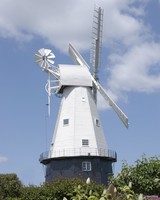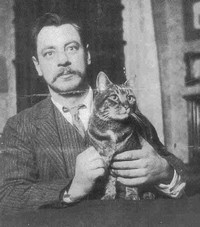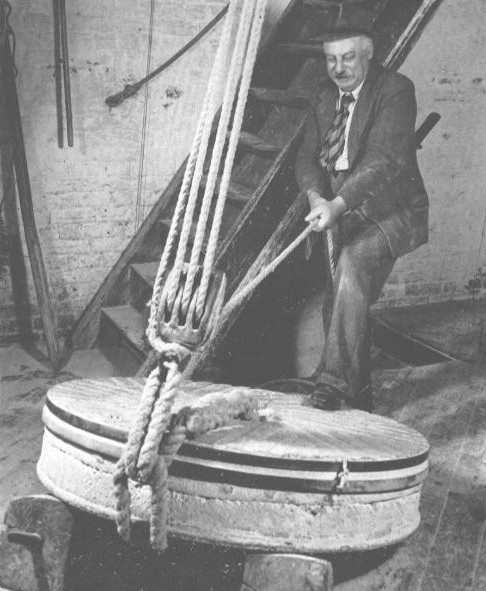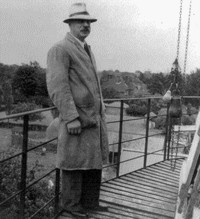
| Union Mill, Cranbrook Registered charity no.1031879
| |
|
John Russell, the Last Miller John, the second son of Caleb Russell, was born at Swanton Watermill, Mersham, which his father owned. When Caleb died in 1918, John became the last commercial owner of the Union Mill. As a youth, he had been apprenticed to Clarkes, the Ashford Millwrights and later worked in mills in Cheshire, which laid the foundation for his expertise as a millwright and miller. During the Great War, he was directed to Samuel White's Shipyard on the Isle of Wight, testing destroyer engines at sea but, when his father died, was released from this work to take over the milling concern. The business at that time was firmly based at Slipmill, Hawkhurst, and the Union windmill at Cranbrook was neglected during his father's tenure. It had lost its fantail, the sweeps were derelict and some of the weatherboard was missing. It had long ceased being wind powered, relying on a steam engine to drive stones on the first floor of the base. The work had been solely grist milling or mixing animal feeds, flour production having stopped fifty years earlier.  John Russell in 1920s, a great cat lover Final Commercial Milling at the Mill
The windmill had been fitted with four good sweeps and a fine fantail and was operating at its peak during the 1920s. To supplement wind power, John relied on the gas engine he had installed to drive two stones on the first floor. He continued to supply a wide range of farms in the parishes around Cranbrook with animal feeds, fertilisers, hay and straw and other necessities. To supplement what he ground at the mill, John also sold proprietary products made by firms such as Paul's, Lillico's, Rank's and British Oil and Cake Mills and the business prospered for the next twenty years or so. John, though, appeared to 'cultivate old age', as a friend once put it. He always used a quill pen, which he sharpened with his pen knife. 'Modern mechanisms' were an anathema to John who disliked telephones and had one installed only when his customers insisted that he should do so. He always wished to keep his firm small and managed his business very well with simple old methods but with utmost honesty and integrity, which brought work to the mill quite naturally. "We are very busy," he once wrote, "indeed, people seem determined to trade with us in spite of our efforts to prevent them!" In his office was a barrel of cider, so when a customer came to pay his account, he would draw him a glass. His love of the windmill, which he attempted to keep in good condition, in spite of the costs, won John a prestigious tribute. In 1935, the Society for the Protection of Ancient Buildings (SPAB), granted John their first Certificate to be awarded, "as a record of their appreciation of his zeal in the maintenance of this beautiful structure."
As John concentrated the work more and more on the Union Windmill, he first sold Swanton watermill at Mersham and then even Slipmill at Hawkhurst, which had been in the family since before 1850 and was at one time the mainstay of the business. Nonetheless, John found that he was having difficulty in competing in the market place, relying on wind power alone. The gas engine was put to more constant use, while the mixing machines on the upper floors were also kept hard at work. However, he continued to use the wind machinery whenever he could, to keep down the cost of gas. Then came the war years, when restrictions and shortages started to affect the business increasingly. The windmill began to need repairs and maintenance which could not be carried out for the lack of spare parts, timber and paint and shortage of labour. John struggled to keep it at work and used it less than he wished, to preserve it.
However, by the end of the war the windmill was only just able to continue working. John's health, too, was not as good as earlier and he found it increasingly difficult to carry out the millwrighting he had originally done almost single-handedly. He reluctantly looked for a partner to inject fresh capital into the business and, in 1952, took on a Mr Charles Lewis, who began a new mill development plan. He demolished most of the old buildings which surrounded the windmill and replaced them by an asbestos-cement factory, with an electric motor to drive the T stones, and ignored the windmill completely. Unfortunately, it did not work and the business grew less and less viable till the partnership was dissolved. John, by now was as worn out as was his old windmill and he turned to his friend, Rex Wailes, the foremost mill expert of the day, for help and advice. Rex Wailes proposed a restoration, with the financial support of many national figures and organisations, but this, too, was unsuccessful. Finally, the Kent County Council were reluctantly prevailed upon to accept responsibility for caring for the mill. John sold it to them for the sum of one shilling and a team of Dutch millwrights were employed to completely repair the windmill. However, on the day they arrived to start work, John, who had been seriously ill, died in 1958 at the age of 78.
Wynn Tremynheere
Go back to Ebenezer, Hugh and Caleb Russell
|

